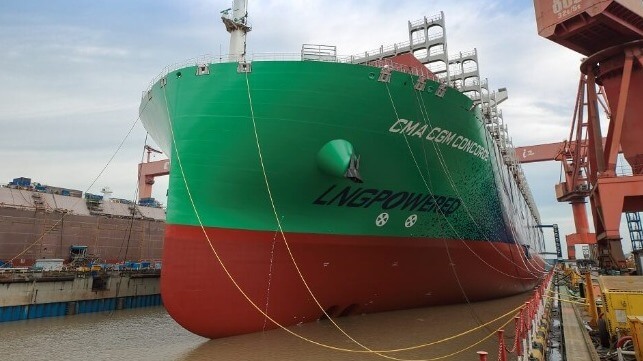Study: LNG Will Be Most Affordable Compliance Option for EU GHG Rules

LNG has its critics in environmental circles, but its fiscal attractiveness is clear, according to industry advocacy group SEA-LNG. Setting aside any debate about LNG's environmental merits, it will be the least-cost option for boxship owners who need to meet EU compliance requirements for GHG reduction, the group argues in a newly-released analysis.
LNG is one of the most affordable marine fuels under normal market conditions, and it has a lower emissions profile than HFO or VLSFO. Using SEA-LNG's estimate for LNG's well-to-wake greenhouse gas reduction benefit - about 20 percent below VLSFO - switching to LNG is itself enough to comply with the FuelEU Maritime GHG reduction requirements out through the year 2039. After that, operators would have to blend in varying proportions of costlier bio-LNG and e-LNG. (E-LNG may be the most expensive alternative fuel, according to the Maersk McKinney-Moller Center for Zero Carbon Zhipping).
As the proportion of "green" fuel in the blend goes up to meet strengthened requirements, so does the cost for compliance - except for ammonia, which declines in price and becomes cheaper than a 50 percent gray / 50 percent renewable LNG mix by 2050. Blue ammonia (produced from natural gas with carbon capture) comes out as the most cost-effective option by midcentury, but not before.
"It is clear from this analysis that the LNG pathway to compliance offers massively lower fuel costs than that for both the methanol and ammonia pathways, particularly in the first 15 years of the vessel’s life – a period critical for vessel financing decisions. The methanol pathway is approximately 2.5 times more expensive and the ammonia pathway, 2.5 to 3.5 times more expensive," concluded SEA-LNG.
Reducing methane slip
Most of the debate around LNG's climate effectiveness centers on methane emissions. Natural gas is mostly methane, a gas with substantially higher warming potential than CO2, and a percentage escapes during upstream extraction, transport and liquefaction. LNG-powered ships also emit varied amounts of methane during operation, with the amount dependent on engine type and operating profile.
This last emissions category - methane slip - has captured the public debate for years, with some environmental groups arguing that it makes LNG an unattractive alternative. Though this debate gets headlines, it may soon be over. The industry's biggest players are quietly working to eliminate engine emissions of LNG by 2030, according to Steve Esau, SEA-LNG's chief operating officer.
"There are a number of companies on the shipping side and the OEM side who are investing a significant amount of money to measure where the operational emissions are coming from on board ship, and then looking at solutions for addressing those," says Esau. "That would be a combination of operational solutions and pre- and post-combustion technologies to deal with methane slip. And I think they're very confident that methane slip will be eradicated by the end of the decade."
